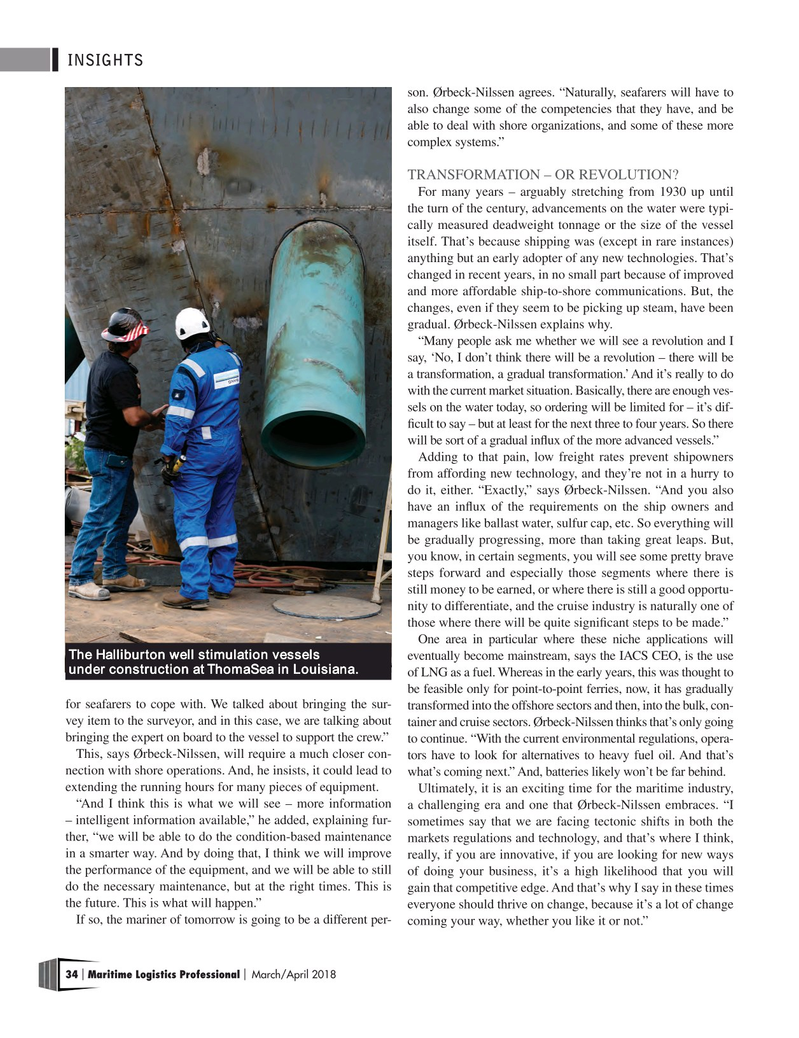
Page 34: of Maritime Logistics Professional Magazine (Mar/Apr 2018)
IT & Software
Read this page in Pdf, Flash or Html5 edition of Mar/Apr 2018 Maritime Logistics Professional Magazine
INSIGHTS son. Ørbeck-Nilssen agrees. “Naturally, seafarers will have to also change some of the competencies that they have, and be able to deal with shore organizations, and some of these more complex systems.”
TRANSFORMATION – OR REVOLUTION?
For many years – arguably stretching from 1930 up until the turn of the century, advancements on the water were typi- cally measured deadweight tonnage or the size of the vessel itself. That’s because shipping was (except in rare instances) anything but an early adopter of any new technologies. That’s changed in recent years, in no small part because of improved and more affordable ship-to-shore communications. But, the changes, even if they seem to be picking up steam, have been gradual. Ørbeck-Nilssen explains why.
“Many people ask me whether we will see a revolution and I say, ‘No, I don’t think there will be a revolution – there will be a transformation, a gradual transformation.’ And it’s really to do with the current market situation. Basically, there are enough ves- sels on the water today, so ordering will be limited for – it’s dif- fcult to say – but at least for the next three to four years. So there will be sort of a gradual infux of the more advanced vessels.”
Adding to that pain, low freight rates prevent shipowners from affording new technology, and they’re not in a hurry to do it, either. “Exactly,” says Ørbeck-Nilssen. “And you also have an infux of the requirements on the ship owners and managers like ballast water, sulfur cap, etc. So everything will be gradually progressing, more than taking great leaps. But, you know, in certain segments, you will see some pretty brave steps forward and especially those segments where there is still money to be earned, or where there is still a good opportu- nity to differentiate, and the cruise industry is naturally one of those where there will be quite signifcant steps to be made.”
One area in particular where these niche applications will
The Halliburton well stimulation vessels eventually become mainstream, says the IACS CEO, is the use under construction at ThomaSea in Louisiana.
of LNG as a fuel. Whereas in the early years, this was thought to be feasible only for point-to-point ferries, now, it has gradually for seafarers to cope with. We talked about bringing the sur- transformed into the offshore sectors and then, into the bulk, con- vey item to the surveyor, and in this case, we are talking about tainer and cruise sectors. Ørbeck-Nilssen thinks that’s only going bringing the expert on board to the vessel to support the crew.” to continue. “With the current environmental regulations, opera-
This, says Ørbeck-Nilssen, will require a much closer con- tors have to look for alternatives to heavy fuel oil. And that’s nection with shore operations. And, he insists, it could lead to what’s coming next.” And, batteries likely won’t be far behind.
extending the running hours for many pieces of equipment.
Ultimately, it is an exciting time for the maritime industry, “And I think this is what we will see – more information a challenging era and one that Ørbeck-Nilssen embraces. “I – intelligent information available,” he added, explaining fur- sometimes say that we are facing tectonic shifts in both the ther, “we will be able to do the condition-based maintenance markets regulations and technology, and that’s where I think, in a smarter way. And by doing that, I think we will improve really, if you are innovative, if you are looking for new ways the performance of the equipment, and we will be able to still of doing your business, it’s a high likelihood that you will do the necessary maintenance, but at the right times. This is gain that competitive edge. And that’s why I say in these times the future. This is what will happen.” everyone should thrive on change, because it’s a lot of change
If so, the mariner of tomorrow is going to be a different per- coming your way, whether you like it or not.” 34 Maritime Logistics Professional March/April 2018 | |

 33
33

 35
35
